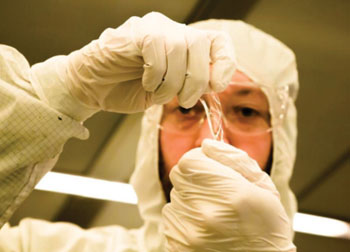Flexible Sensors Promote Healthier Work Environments
By HospiMedica International staff writers
Posted on 07 Jul 2015
A new study describes wearable sensor patches that use transparent, flexible, electronics to detect harmful ultraviolet radiation and toxic gases such as hydrogen and nitrogen dioxide.Posted on 07 Jul 2015
Developed by researchers at RMIT University (Melbourne, Australia), the stretchable and tunable microtectonic sensors are based on oxygen-deficient, nano-patterned zinc oxide (ZnO) thin films placed on an elastomeric substrate. The surface structure is then exploited to create the stretchable gas and ultraviolet (UV) light sensors. The nanoscale ZnO films embedded in the elastomeric matrix function as tunable diffraction gratings, capable of sensing displacements with nanometer accuracy.

Image: Senior author Madhu Bhaskaran, PhD, holding the stretchable microtectonic sensors (Photo courtesy of RMIT).
The stretchable ZnO itself was found to outperform rigid counterparts under room temperature conditions, and according to the researchers, the microtectonic oxide thin film approach shows promise in enabling functional, transparent, and wearable ultraportable sensors. For example, they can be used to detecting harmful levels of UV radiation known to trigger melanoma, and could even be linked to electronic devices to continuously monitor UV levels and alert the user when radiation hits harmful levels. The study was published on June 5, 2015, in Small.
“Zinc oxide, present in most sunscreens as a fine powder mixed into a lotion, was used as the UV sensing material,” said lead author Philipp Gutruf, PhD, of the RMIT Functional Materials and Microsystems Research Group (FMMRC). “This thin zinc oxide layer is engineered with a plate-like structure that we call micro-tectonics; these plates can slide across each other bit like geological plates that form the earth’s crust, allowing for high sensitivity and the ability to bend and flex the devices.”
“Hydrogen leaks can lead to explosions as happened with the Hindenburg disaster, and nitrogen dioxide is a major contributor to smog,” added senior author Madhu Bhaskaran, PhD, also of the RMIT FMMRC. “The ability to monitor such gases in production facilities and coal-fired power stations gives vital early warning of explosions, while the ability to sense nitrogen dioxide allows for a constant monitoring of pollution levels in crowded cities.”
The concept of realizing electronic applications on elastically stretchable "skins" that conform to irregularly shaped surfaces is revolutionizing fundamental research into mechanics and materials that can enable high performance stretchable devices. The ability to operate electronic devices under various mechanically stressed states can provide a set of unique functionalities that are beyond the capabilities of conventional rigid electronics.
Related Links:
RMIT University














